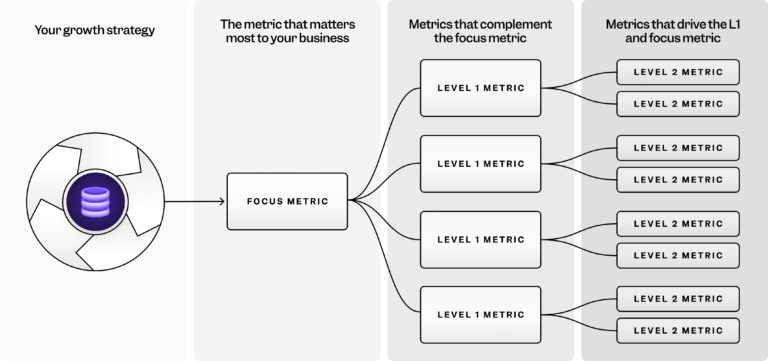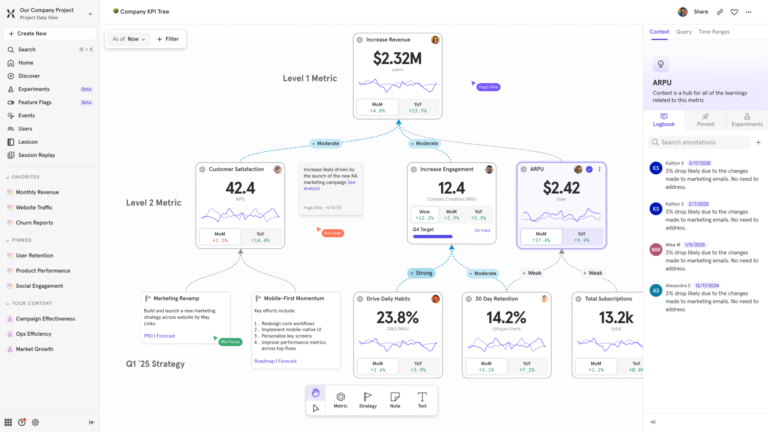Metric trees 101: A practical guide, the benefits, and process of building your tree
Today, businesses are drowning in data, yet many are stuck in a foundational or descriptive phase of analytics. They can report that sales are up, but they struggle to answer why and, more importantly, what to do next to have a meaningful impact. This gap is where the limitations of the single North Star metric become clear.
While a North Star is crucial for digital product companies and aligns teams to a single goal, focusing on it exclusively can turn it into a black box. It tells you where you're going, but not the specific, interconnected components that drive it, leading to a lack of precise actionability and siloed decision-making.
All this data needs more structure
The solution isn’t more data, but a structured approach to it. The metric tree is an interactive map that offers a unified, comprehensive, connected plan to link high-level business goals directly to daily team actions.

These key insights are synthesized from an on-demand webinar series on “Beyond the North Star: Turning Data into Impact with Metric Trees” featuring industry leaders who have navigated this journey and offer a practical guide to turning data into true business impact.
- Corinna Stukan, Founder of InsightsDrivenPM | CEO at Bizzy
- Karl Thumm, Senior Director of Data & Analytics at Zola
- Dr. Tim Wiegels, Executive Data Advisor | Founder of the Tim Wiegels Data Solution
The problem: Peril of a single metric
A single, high-level metric can be misleading, concealing underlying issues and causing significant organizational problems. Without a connected framework, teams often work in silos, optimizing their individual metrics without considering the broader business context. This can lead to a domino effect of issues.
Organizational misalignment
This happens when departments, like marketing and product, pursue conflicting goals.
For example, a marketing team might aim for a high volume of new users, while the product team focuses on retaining a specific user type. This can lead to counterproductive results, which Corinna Stukan experienced when a marketing campaign offering a $100 sign-up bonus successfully attracted new users who were not interested in the product itself. This made both the marketing and product teams less effective.
Lack of holistic view
When teams don't understand how their daily work connects to overall business goals, they can fall into a “black box paradox” where a seemingly successful action on a narrow metric undermines broader company objectives.
For instance, Dr. Tim Wiegels shared that when he was at FreeNow, a product team trying to improve a ride-booking conversion rate injected a €2 voucher. This caused their metric to skyrocket but completely eliminated the company's profit on those rides, which was typically between €1.50 and €2.50.
Lack of accountability
When teams don't understand how their actions impact broader business outcomes, it’s easy for accountability to slip through the cracks. This leaves teams feeling removed from the results of their actions and can ultimately hurt morale and focus.
The solution: Metric tree as a strategic blueprint
The most effective solution leading companies employ to bridge the gap between daily work and high-level business goals is a metric tree.
A metric tree is a strategic blueprint that serves as a hierarchical decomposition of business goals, fundamentally re-framing how an organization uses its data. It's a powerful tool that connects strategic priorities with daily team actions, providing a multi-metric, interconnected view that overcomes the black box problem of a single North Star metric. This framework allows teams to understand not only what happened, but also how their work specifically influences the ultimate business outcome.
The value of a metric tree goes beyond simple visualization; it's a dynamic tool that transforms how organizations diagnose problems, prioritize work, and collaborate. Here’s an example built in Mixpanel:

Key benefits of a metric tree
1. Diagnosing the why
The metric tree is a visual way of performing the five whys to get to the root cause of a change. By following its branches, teams can quickly pinpoint the exact source of an issue, directing their efforts toward specific, actionable levers. This moves teams away from reactive problem-solving and toward a data-driven approach to root cause analysis.
2. Separating signal from noise
A metric tree provides a framework for distinguishing between a vanity metric and an actionable one. For example, a superficial analysis might favor a funnel with a large number of users but a low conversion rate. However, if a second funnel with fewer users has a higher conversion rate and those users have double the lifetime value, a metric tree would make this prioritization clear by showing the true value-focused path.
3. Prioritizing with data
A metric tree's ability to show the quantitative relationship between metrics transforms it into a prescriptive tool for prioritizing a team's roadmap. The tree can display a correlation feature that shows how lower-level metrics relate to the North Star, helping teams quantitatively prioritize their efforts and avoid wasting time on metrics that don't actually move the needle.
4. Promoting alignment and accountability
As a powerful silo buster, the metric tree fosters a shared understanding of success across different departments. By creating a common language and a visual map for alignment, it ensures teams understand how their actions impact broader business outcomes, thereby improving accountability and morale. The process of building the tree itself is a collaborative effort that forces teams to confront and resolve definitional disagreements, laying a critical foundation for a unified strategy.
* For best practices in building a metrics strategy, visit this blog.
The process: A practical guide to building your metric tree
Building a metric tree is a continuous journey that begins with a collaborative effort and evolves over time. The key is to “just get started” and follow a phased, iterative approach.
Deconstruct your business goals
Begin by clearly defining what success looks like for your business. This involves conversations with senior leadership to get a clear understanding of their overarching business goals, such as increasing revenue or reducing costs. From this top-level goal, work backward to decompose it into two or three key primary drivers.
For a SaaS company, this might involve defining what an active user truly means. For an ecommerce business, a North Star like customer lifetime value could be broken down into drivers such as first-time buyers and average order value.
Collaborate and build the blueprint
Start with a small, cross-functional team including representatives from product, marketing, sales, and customer success. The goal is to build a single pilot metric tree together, fostering a shared understanding of the process. Each department can craft its own tree tailored to its domain, reflecting its unique metrics. Teams should then collectively review their trees to identify overlaps and standardize definitions. This process, as seen by Karl Thumm at Zola, helps to align departments and reveals just how shared everyone's focus areas are together.

Make it a living ritual
A metric tree is not a one-time project; it's a living, measurable growth strategy integrated into your organizational workflows.
Once the initial tree is built, make it a regular practice by scheduling quarterly or bi-annual reviews. This ensures the tree remains relevant and is used as a tool for everything from weekly business reviews to high-level quarterly planning. Such an approach saves teams immense time in reporting and analysis and fosters a data-driven culture by keeping discussions focused and directly connected to data. The same tree structure can be used for a variety of purposes, turning it into a central hub for strategy and a common language for the entire organization.
Stop chasing a number, build the roadmap instead
The journey from being a company that merely reports on data to one that uses it for prescriptive, impactful action isn’t a simple one. It requires a fundamental shift in mindset and a new framework for thinking about success. While a North Star metric is a necessary first step for providing a high-level direction, a metric tree transforms that single number into an actionable, transparent roadmap.
A metric tree moves an organization beyond the black box paradox by visually linking high-level goals to the low-level actions that drive them. It enables teams to diagnose the “why” behind a change, separate valuable signals from meaningless noise, and collaborate with a shared understanding of success.
Ultimately, the metric tree is a mechanism for fostering a data-driven culture, turning a collection of siloed metrics into a unified, strategic force. The most important action is to begin the journey now. Stop chasing a single number and start building a roadmap for true impact.
Learn more in our metric trees webinar series or get a demo today.


